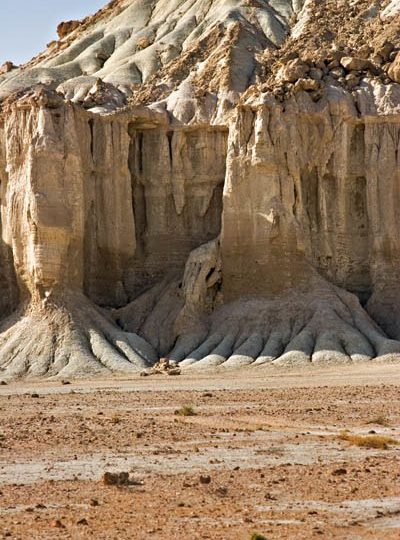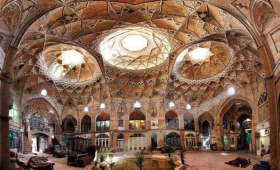Valley of statues, Qeshm is one of the most beautiful Iranian islands in the Persian Gulf. This island is considered the first Geopark in the Middle East and has unique natural attractions. The Valley of Statues is one of the sights of Qeshm, that has become famous due to the presence of stones with statues. Every year, many tourists travel to Qeshm to visit this valley and its sedimentary phenomena; A valley that is very similar to the valley of stars. It is interesting to know that in the distant past in this dry and cracked plain, there was a sea and living creatures lived in it.
The valley of statues is one of the sights of Hormozgan province and it is located in the center of Qeshm Island towards the west. This amazing valley, that is one of the sites of Qeshm Geopark, is located 5.5 kilometers southwest of a village called Tabal and in the southern part of the Hara forest.
Geopark are places with interesting and spectacular geological phenomena that may have historical, ecological, archeological, cultural and other natural heritage in addition to geological phenomena. Geopark of Qeshm Island is the first and only Geopark of the Middle East, that was registered by UNESCO in the Global Geopark Network (GGN) in 2006. After China, Malaysia, Korea, Japan and Vietnam, Iran is known as the sixth Asian country with a Geopark.
Qeshm Geopark has 25 geosites, that include Stars Valley, Korkurakuh, Bam Qeshm, Valley of Statues, Shur Valley, Chahkoh Strait, Namakdan, Karyan, Geopark Museum, Mudflats, Karag Beach, Ghazi Valley, Oli Strait, Basira, Chakvir, Naz Islands. , Geo Link, Basaeido, Derestan Bay, Mangrove Forest, Turtle Spawning Beach, Crab Rock, Laft Village, Khorbes Cave, Du Kohk Bird Wetland and Chahkouh Gorge.
To go to the Valley of the Statues, you need to take a road along the western side of Qeshm Island to a side road and move through the mangrove forest towards the village of Tabal. Then go down again on the path of Salakh towards Bam Qeshm to come across giant statues in a high area. The valley of statues is located in the middle of the road on the way from Tabal village to Maleki village. According to the investigations carried out by geological researchers, the history of the valley of statues goes back to millions of years ago. It is said that Qeshm Island emerged from the water almost 50,000 years ago.
According to some researchers, the valley of the statues is more than two million years old and was created due to the erosion of soil, stone and sand in the Cenozoic geological period (about two million years ago). The effect of the mechanical erosion of running water caused by rainfall has been the most influential factor in the formation of this phenomenon, and factors such as the difference in material and resistance of different layers, the presence of veins and between layers of gypsum or plaster, and the movements and internal pressures of the earth have also had an effect on it. The reason for naming the Valley of Statues or the Valley of Statues with this name is the existence of stones with different shapes in this valley; Stones, some of which are human-shaped and others are similar to animals such as chickens, roosters, sheep’s heads, and even dragon’s heads. Of course, you should know that these statues were formed in a natural way and are actually accidental, that only with our imagination, humans look like statues. The Valley of Statues is one of the most important attractions of Qeshm where you will see interesting, surprising and strange forms. This valley is the art of wind and rain erosion that have created a series of different shapes and designs over millions of years. The Valley of the Statues is structurally similar to the Valley of the Stars; with the difference that it has a larger area and the density of the phenomenon is less there. The Valley of Stars is located in the east of Qeshm Island and just opposite to the Valley of Statues.
The stones of the valley of Qeshm statues are carved in a precise and artistic way; So that it seems very hard to believe that no artist’s ax carved these statues. What you see in the Tandisha Valley area is actually the remnant of a plain that once reached the roof of Qeshm. With the gradual rise of the island and retreat of the coast, the land area expanded and the Valley of the Statues was created. The destruction and loss of the hard limestone layer, which was a cover between the soft erosive layers, caused the progress of the erosion process in this area, and for this reason, the Valley of the Statues can be introduced as an island-like height among worn and low lands.
At present, the valley of the statues is one of the parts of Qeshm Island that has suffered significant coastal erosion; The erosion that occurred during the years when Qeshm Island gradually came out of the water created many engravings on the rocks.
The valley of the statues was once the sea bed and all kinds of fish, molluscs and aquatic animals lived in these cracks. The entire soil of Tandisiha Valley is full of bivalve shells that are left over from the past and are gathered in some places. The surface of the valley of the statues is often covered with mud cracks. A mud pit is a sedimentary structure that is discussed in sedimentological topics. These sedimentary phenomena are remarkable sights in the valley of statues that show you a beautiful view of the valley. It should be noted that during rain or after rain, the ground in these places becomes very sticky and swampy.
The Valley of the Statues is a wonderful subject for photography, and with a little creativity, you can take amazing photos of the amazing attraction and its various shaped rocks. Don’t forget to buy handicrafts in this valley. Sometimes the local residents brought their beautiful handicrafts to the Valley of the Statues; Souvenirs made of shells and abalones are suitable gifts for loved ones and beautiful souvenirs.
If you are lucky, you will also meet camels on the way to the valley of statues. Walking and hiking at night in Tandisaha valley is one of the attractions that tourists are very interested in.
Bam Qeshm is a semi-elevated area between the villages of Tabal and Salekh, to reach it you have to walk for 15 minutes from the end of the road by car. From the top of this plateau, you can see the view of the mangrove forest and the northern coast of the Persian Gulf. The valley of statues can also be seen from the south. The vegetation of this area is in the form of thick trees and limestone and shell shells are visible.
Bam Qeshm is an ancient site. Archaeologists have found stone tools such as axes and knives in this area, and these discoveries show that the first human settlement in the Persian Gulf area was Bam Qeshm. The tools and objects discovered date back to the end of the Paleolithic era, more than 150 thousand years ago. The pottery and baked clay discovered on the roof of Qeshm also prove that life continued here in the post-Islam period.
Goran Dam is located near Goran village, on Tabal-Basaid road and dates back to the Pahlavi period. But according to the findings of archaeologists, its first foundations are related to the Achaemenid period and the crown of the dam is related to the Sassanid period. This work has been registered as one of Iran’s national works. It is said that the name Goran is derived from the word Gubaran, and this village was most likely the place of residence of Zoroastrians. Goran barge-making workshop is one of the other sights of Goran village near the dam, which you should not miss.




